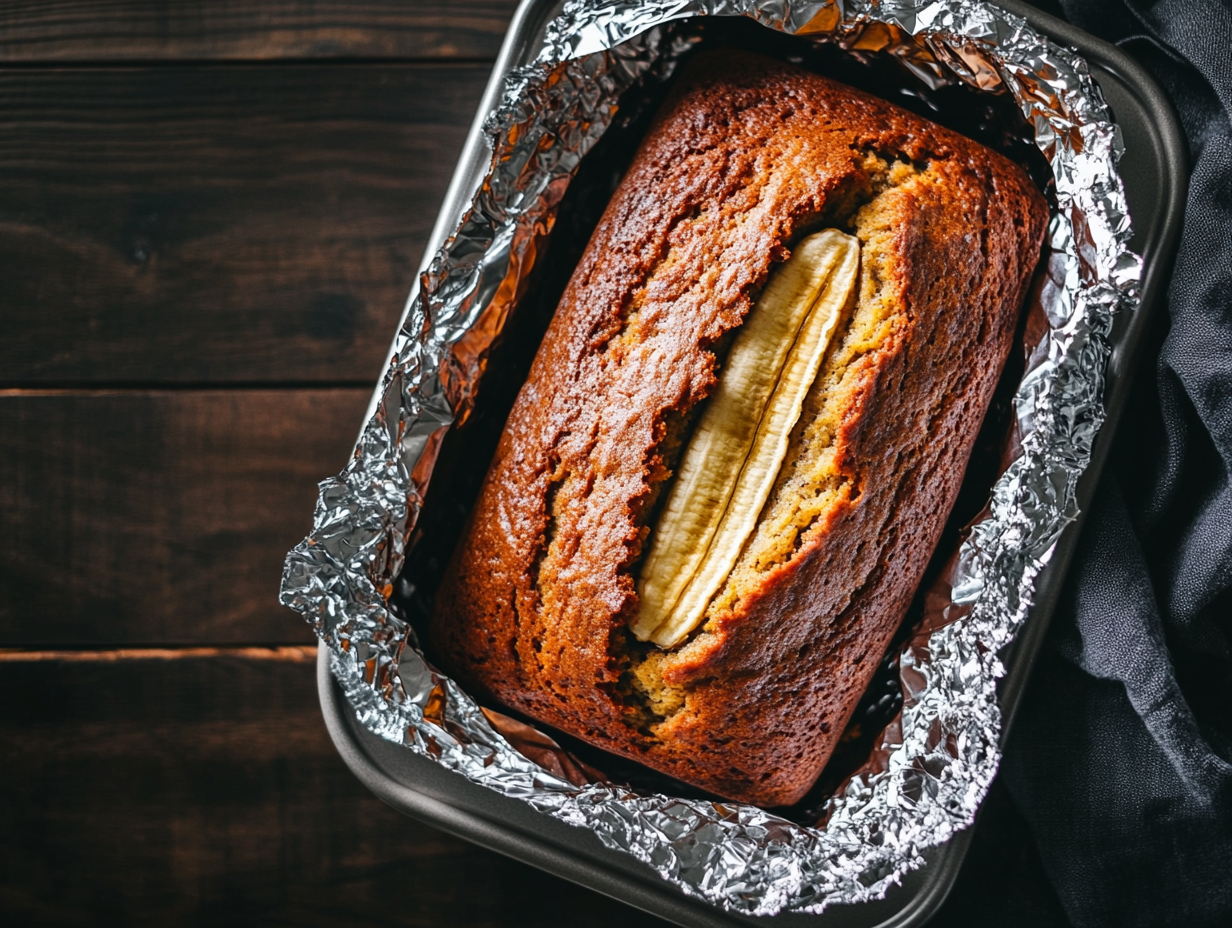Introduction: Why Is My Banana Bread So Moist? Tips, Tricks, and Solutions
Banana bread is one of those comforting classics that everyone loves. But occasionally, you might find your loaf turning out overly moist—or worse, soggy. Understanding the factors that influence your banana bread’s texture is key to nailing that perfect loaf every time. This article will unravel the reasons behind its moisture level and provide step-by-step solutions to troubleshoot and master the art of moist banana bread.
Part 1: Understanding Banana Bread Moistness
The Appeal of Moist Banana Bread
Banana bread’s moist texture is what makes it irresistible to many. It’s the hallmark of a well-baked loaf, where every slice offers a soft, tender bite that almost melts in your mouth. Achieving this balance, however, depends on a harmonious interplay between the ingredients, baking techniques, and storage methods.
Not too dry, not too wet—getting this Goldilocks balance is an art. Whether you’re baking for family, friends, or yourself, understanding why moisture matters is the first step toward banana bread perfection.
Common Concerns About Excess Moisture
But what if your banana bread is too moist? A soggy loaf can result from various factors, such as overly ripe bananas, imprecise measurements, or incorrect baking times. Excess moisture isn’t just a texture issue; it can also mask the flavors and make the bread less appetizing.
Luckily, these issues are fixable! In this guide, we’ll break down all the elements—ingredients, methods, and troubleshooting—to ensure your banana bread always hits the sweet spot.
Part 2: Key Factors Influencing Moisture in Banana Bread
Ingredients and Their Impact
The secret to banana bread’s moist texture lies heavily in its ingredients. Each component contributes uniquely to the final outcome, and even minor adjustments can make or break the balance. Let’s dive into the essentials.
Role of Overripe Bananas
Overripe bananas are the heart of any banana bread recipe. Their soft, mushy texture and high sugar content make them perfect for creating moist bread.
- Sugar Content in Overripe Bananas: The natural sugars in bananas caramelize during baking, adding a subtle sweetness and contributing to moisture. Aim for bananas with plenty of brown spots; the riper, the better.
- Moisture Contribution: Overripe bananas also contain more liquid, which gets incorporated into the batter. However, using too many bananas can overwhelm the mixture and leave it soggy.
Influence of Fats
Fats, whether butter, oil, or substitutes like sour cream, are essential for a moist crumb. But each option has its quirks.
- Butter vs. Oil: Butter gives a rich flavor, while oil provides better moisture retention. For an ultra-moist loaf, many bakers swear by using oil or a combination of the two.
- Sour Cream and Yogurt Additions: These dairy products are magic for banana bread. They add tanginess and enhance the texture without overpowering the banana flavor.
Sugar Types and Quantities
The type and amount of sugar can greatly influence the texture.
- Brown Sugar vs. White Sugar: Brown sugar adds a deeper flavor and more moisture due to its molasses content. Using a mix of both creates a nice balance.
- Honey and Other Sweeteners: Honey, maple syrup, or even agave can be used as alternatives to sugar, but they may require adjustments to the other wet ingredients to maintain consistency.
Egg Quantity and Size
Eggs are the glue that holds everything together, but they also play a role in moisture.
- Binding Properties: Eggs provide structure, ensuring your banana bread doesn’t crumble apart.
- Moisture Addition: Too many eggs, however, can result in a denser and wetter texture. Stick to the recipe’s egg count unless you’re experimenting.
Part 3: Baking Techniques Affecting Moisture Levels
Mixing Methods
The way you mix your banana bread batter plays a critical role in achieving the ideal moist texture. Overmixing or undermixing can lead to vastly different outcomes.
Importance of Proper Mixing
- Avoiding Overmixing: When you overmix the batter, you activate the gluten in the flour, which can result in a tougher and denser bread. This not only affects the texture but can also trap excess moisture unevenly.
- Ensuring Ingredient Incorporation: On the flip side, undermixing can leave you with clumps of flour or uneven pockets of moisture. Mix until just combined for the best results.
Batter Consistency
Getting the batter’s consistency right is like finding the perfect rhythm—it’s all about balance.
- Indicators of Correct Consistency: The batter should be thick yet pourable, resembling a lumpy pancake mix. If it’s too runny, it could signal an imbalance in the wet and dry ingredients.
- Adjusting for Desired Moisture: If the batter appears overly thick, a splash of milk or a spoonful of yogurt can help; if it’s too thin, a touch of flour can save the day.
Baking Time and Temperature
Even with the perfect batter, incorrect baking can sabotage your banana bread’s moisture levels. Let’s break down why time and temperature matter.
Oven Temperature Accuracy
- Effects of Incorrect Temperatures: Baking at too high a temperature may cook the outer layer too quickly, leaving the inside underbaked. Too low, and you might end up with a dense, gummy loaf.
- Using Oven Thermometers: Ovens can be unpredictable. An inexpensive oven thermometer can help you ensure accurate temperatures for consistent results.
Determining Doneness
Knowing when your banana bread is fully baked is crucial to maintaining the right moist texture.
- Toothpick Test: Insert a toothpick into the center of the loaf. It should come out with a few moist crumbs, but not wet batter.
- Internal Temperature Guidelines: For precision, use a food thermometer. The internal temperature should reach about 200°F (93°C) when fully baked.
Part 4: Storage and Its Impact on Moisture
Cooling Methods
Properly cooling banana bread is often overlooked, but it can make or break the texture. Rushing this step can trap steam, while cooling too long can dry out your loaf.
Importance of Proper Cooling
- Preventing Sogginess: Allow your banana bread to cool in the pan for about 10–15 minutes. Removing it too soon can cause it to fall apart, while leaving it in too long can make the bottom soggy.
- Maintaining Texture: Once it’s firm enough to handle, transfer the loaf to a wire rack. This ensures that air circulates around the bread, preventing moisture buildup.
Storage Techniques
How you store banana bread affects not only its moist texture but also its flavor and freshness.
Wrapping and Containment
- Use of Plastic Wrap and Foil: Wrap your loaf tightly in plastic wrap or aluminum foil to prevent air exposure, which can dry out the bread.
- Airtight Containers: Placing the wrapped loaf in an airtight container provides double protection against dryness. This is especially helpful if you’re storing it for more than a couple of days.
Refrigeration vs. Room Temperature
- Effects on Moisture Retention: While refrigeration can extend shelf life, it can sometimes dry out banana bread. To avoid this, consider wrapping the loaf tightly and adding a damp paper towel inside the container to maintain moisture.
- Recommended Storage Practices: For the best flavor and texture, store banana bread at room temperature for up to two days. For longer storage, freeze it in slices or as a whole loaf.
Expert Tip: Want a guide to proper wrapping techniques for baked goods? Check out this resource on bread storage.
Part 5: Troubleshooting Excess Moisture in Banana Bread
Identifying the Problem
Before you can fix an overly moist loaf, it’s important to pinpoint the root cause. Excess moisture can stem from issues with ingredients, baking techniques, or storage.
Signs of Overly Moist Banana Bread
- Soggy Bottoms: If the bottom of your loaf is damp or gummy, it could be due to underbaking or too much liquid in the batter.
- Dense, Gummy Texture: A loaf that feels sticky or clings to the knife when sliced is often a result of ingredient imbalances or inadequate baking.
Common Causes and Solutions
Now that you’ve identified the signs, let’s tackle the most frequent culprits and how to fix them.
Ingredient Misproportions
- Excess Banana or Liquid Additions: While overripe bananas are crucial for moisture, using too many can lead to an unbalanced batter. Stick to about 1 cup of mashed bananas for most recipes.
- Incorrect Flour Measurements: Measuring flour by volume instead of weight can lead to inconsistency. Always spoon and level your flour or invest in a kitchen scale for accuracy.
Baking Errors
- Inadequate Baking Time: Pulling the bread out of the oven too soon is a common mistake. Even if the top looks done, the center may still be undercooked. Check with a toothpick or thermometer to confirm doneness.
- Oven Hot Spots: Uneven heat distribution can cause certain parts of your loaf to cook faster than others. Rotate the pan halfway through baking to avoid this problem.
Part 6: Frequently Asked Questions
How can I make my banana bread less moist?
To reduce excess moisture in your banana bread, first ensure you’re not using too many bananas or other liquid ingredients. Stick to the recipe’s recommended proportions, and always measure accurately. Baking the bread a little longer at a slightly lower temperature can also help evaporate extra moisture while avoiding overbaking the crust.
Is it safe to eat soggy banana bread?
Soggy banana bread is safe to eat as long as it’s fully baked and doesn’t have an unpleasant or off smell. However, if the bread feels excessively wet or undercooked, it’s best to avoid eating it. Re-baking the loaf for 10–15 minutes may help firm it up.
Can I fix undercooked banana bread?
Yes, you can! Place the loaf back into the oven at 300°F (150°C) and bake for an additional 10–20 minutes. Cover the top with foil to prevent overbrowning while the center finishes cooking. Be sure to check doneness using a toothpick or thermometer.
What is the best way to store banana bread to maintain optimal moisture?
Wrap your banana bread tightly in plastic wrap or foil and store it in an airtight container at room temperature for up to two days. For longer storage, freeze the bread in slices or as a whole loaf. Refrigeration is an option, but it can slightly dry out the bread unless properly wrapped.
How do different types of flour affect banana bread moisture?
Flour type impacts texture and moisture. All-purpose flour is versatile and provides a balanced crumb, while whole wheat flour can absorb more liquid, potentially making the loaf denser. Adjusting wet ingredients when using alternative flours like almond or coconut is crucial for maintaining the right consistency.
Why does my banana bread turn out dry sometimes?
Dry banana bread usually results from overbaking, insufficient fat or liquid, or too much flour. To prevent this, follow the recipe’s ingredient ratios carefully, use a timer to avoid overbaking, and consider adding ingredients like sour cream or yogurt for extra moisture.
Conclusion
Mastering the art of moist banana bread doesn’t have to be complicated. By understanding the role of ingredients like overripe bananas, the effects of baking techniques, and the importance of proper storage, you can consistently bake a loaf that’s perfectly tender and flavorful.
Remember, balance is key. Too much moisture can result in a soggy loaf, while too little can make it dry and crumbly. Pay attention to details like accurate measurements, proper mixing, and baking time to achieve the best results. And when in doubt, follow proven tips like incorporating sour cream or ensuring your oven temperature is spot-on.
With these insights and a bit of practice, your banana bread will no longer be a mystery—it’ll be a masterpiece. Whether you’re troubleshooting or perfecting your favorite recipe, these tips will guide you to that delightful, moist texture everyone loves.

